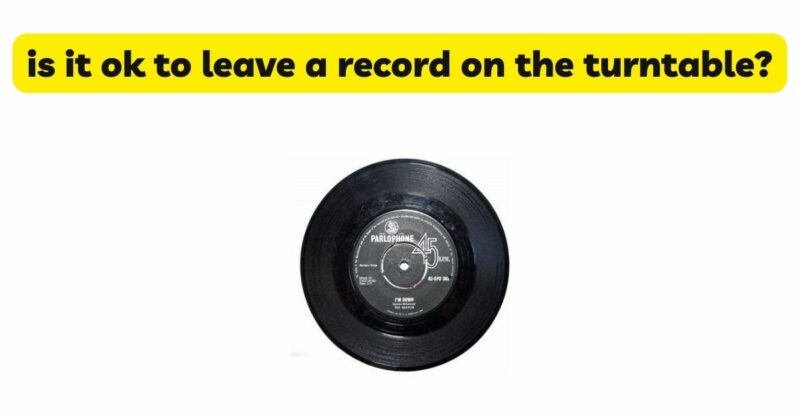Vinyl records, with their nostalgic appeal and warm sound, have made a remarkable comeback in recent years. As vinyl enthusiasts indulge in the ritualistic experience of playing records, a common question arises: Is it okay to leave a record on the turntable? In this article, we will explore the potential benefits and drawbacks of leaving a record on the turntable for extended periods. By examining factors such as stylus wear, record warping, and environmental conditions, we can determine the best practices for preserving the longevity and sound quality of our cherished vinyl collections.
- Stylus Wear and Record Damage
One of the primary concerns when leaving a record on the turntable is the potential for stylus wear and record damage. Here are some key considerations:
a) Stylus Pressure: When a record remains in constant contact with the stylus, even when not actively playing, there is a chance of increased stylus wear. The stylus exerts pressure on the record’s grooves, and over time, this pressure can cause microscopic wear and tear, leading to degradation in sound quality.
b) Dust and Debris Accumulation: Leaving a record exposed on the turntable can result in dust and debris settling onto its surface. When the stylus passes over these particles during playback, it can cause scratches and impact the overall sound quality.
c) Groove Compression: Extended contact between the stylus and the vinyl can potentially lead to groove compression, particularly if the stylus is pressing down with excessive force. Groove compression alters the shape of the grooves, affecting the accuracy and fidelity of the playback.
d) Warping: Records are susceptible to warping, especially when exposed to heat or direct sunlight. Leaving a record on the turntable for prolonged periods, particularly in environments with fluctuating temperatures or sunlight exposure, increases the risk of warping, which can render the record unplayable or result in compromised sound quality.
- Environmental Considerations
Environmental conditions play a crucial role in determining whether it is safe to leave a record on the turntable. Consider the following factors:
a) Temperature and Humidity: Vinyl records are sensitive to temperature and humidity fluctuations. Exposure to high temperatures or excessive moisture can cause the record to warp or develop mold. It is essential to maintain a stable and controlled environment for your records to avoid potential damage.
b) Sunlight Exposure: Direct sunlight can cause records to heat up rapidly, leading to warping or even melting. Prolonged exposure to UV rays can also degrade the vinyl material and impact the sound quality. It is advisable to keep records away from direct sunlight and store them in a cool, shaded area.
c) Dust and Contaminants: Leaving a record exposed on the turntable increases the likelihood of dust accumulation and contamination. Dust particles can settle on the record’s surface, affecting playback and potentially causing scratches. Proper storage in protective sleeves or covers can help mitigate dust-related issues.
- Benefits of Leaving a Record on the Turntable
While there are valid concerns about leaving a record on the turntable, there are also potential benefits to consider:
a) Convenience and Accessibility: Leaving a record on the turntable allows for quick and easy access to your favorite music. Instead of repeatedly removing and storing records, leaving them ready for playback can enhance the listening experience and encourage spontaneous enjoyment of your collection.
b) Reduced Handling: Handling records introduces the risk of accidental drops or mishandling, which can lead to scratches or other damage. By leaving a record on the turntable, you minimize the need for frequent handling and decrease the chances of mishaps.
c) Reduced Setup Time: Setting up a turntable and properly aligning the stylus can be a time-consuming process. Leaving a record on the turntable eliminates the need for repetitive setup, making it more convenient to play records spontaneously.
- Best Practices for Leaving a Record on the Turntable
If you decide to leave a record on the turntable, follow these best practices to minimize potential risks and ensure the longevity of your vinyl:
a) Use a Turntable Cover: Investing in a turntable cover or dust cover provides protection against dust, debris, and sunlight. When not actively playing a record, keep the cover closed to shield the turntable and record from environmental factors.
b) Optimize Stylus Pressure: Adjust the tracking force of your stylus to the manufacturer’s recommended specifications. Avoid excessive stylus pressure, as it can accelerate stylus wear and groove damage.
c) Regular Cleaning: Clean the stylus and record surface regularly to remove dust and debris. Use a stylus brush or cleaning solution designed for vinyl playback to maintain optimal sound quality and minimize the risk of scratches.
d) Control the Environment: Ensure your turntable is placed in a stable environment with controlled temperature and humidity levels. Keep records away from direct sunlight, sources of heat, and excessive moisture to prevent warping and damage.
e) Monitor Playback Time: If you choose to leave a record on the turntable for an extended period, consider periodically lifting the stylus to minimize prolonged contact with the vinyl. This helps reduce the risk of stylus wear and groove compression.
Conclusion
Leaving a record on the turntable can offer convenience and accessibility, but it also poses potential risks to the stylus, record, and overall sound quality. Stylus wear, record warping, dust accumulation, and environmental factors must be considered when deciding whether to leave a record on the turntable. By following best practices such as using turntable covers, controlling the environment, regular cleaning, and monitoring playback time, you can mitigate potential risks and ensure the longevity of your vinyl collection.


